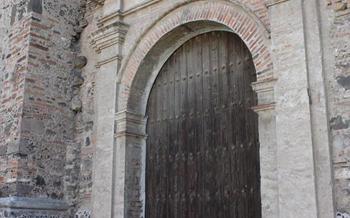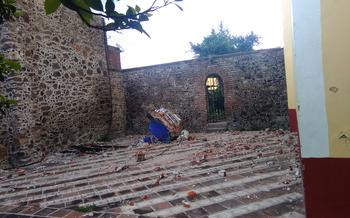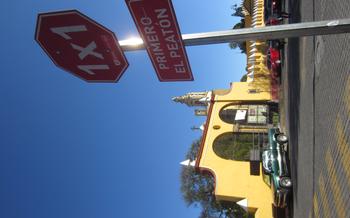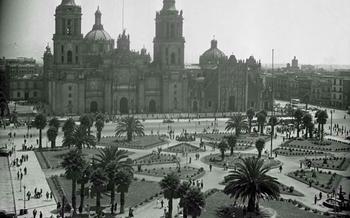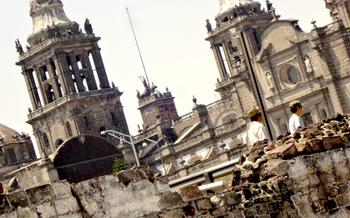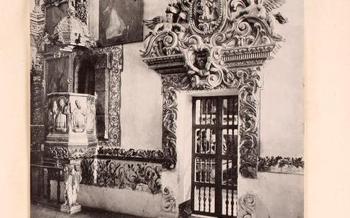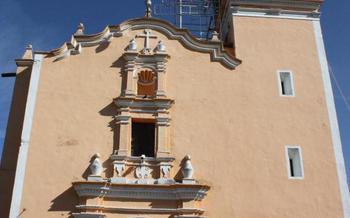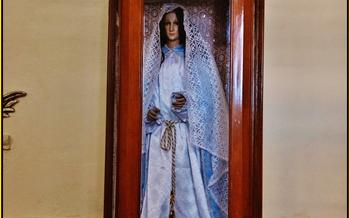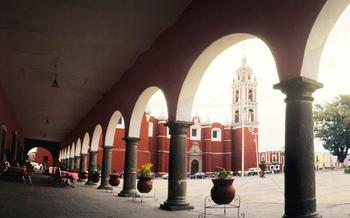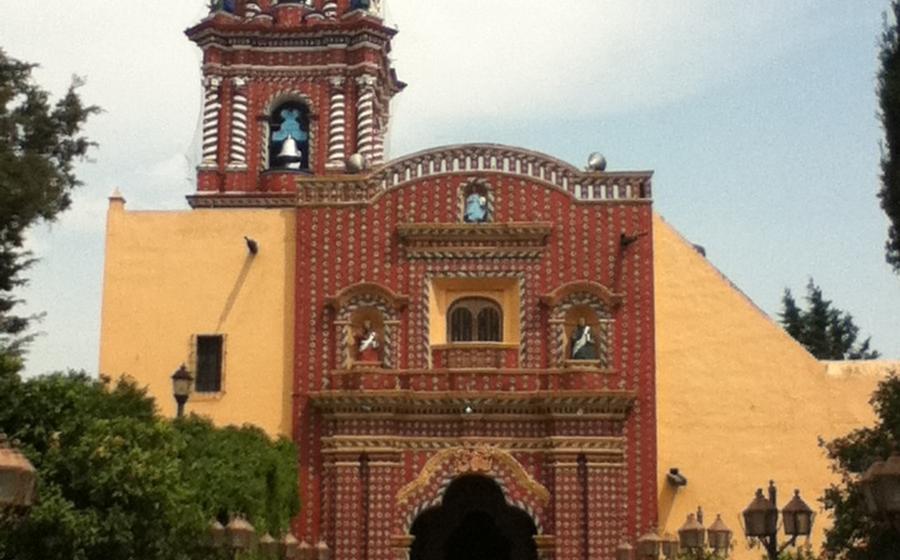
Santa María Tonantzintla Church
- The Architecture of the Church:
- The Murals of the Church:
- The Altars of the Church:
- The People of Cholula
- Getting to Cholula:
- Planning Your Trip
- Budget Tips for Travelers
- Responsible Tourism
The Architecture of the Church:
The architectural style of the Santa María Tonantzintla Church is a unique blend of indigenous and European elements, creating a masterpiece that is both captivating and awe-inspiring. The indigenous influence is evident in the use of bright colors, intricate carvings, and symbols that hold deep cultural significance. The European influence is reflected in the overall design of the church, which follows a traditional Catholic basilica plan with a nave, transepts, and apse.
The intricate carvings and decorations are a testament to the skill and artistry of the indigenous craftsmen who worked on the church. The walls are adorned with intricate floral and geometric designs, while the facade is embellished with sculptures depicting biblical scenes and figures. The symbolism behind these decorative elements is rich and varied, representing everything from the creation of the world to the salvation of mankind.
The church's unique blend of indigenous and European architectural styles makes it a significant contributor to the architectural heritage of Mexico. It is a testament to the cultural exchange and synthesis that took place during the colonial period and stands as a symbol of the blending of two worlds. In recognition of its exceptional value, the Santa María Tonantzintla Church was designated a UNESCO World Heritage Site in 199
The Murals of the Church:
The walls of the Santa María Tonantzintla Church are adorned with stunning murals that depict biblical scenes, local legends, and the history of the church itself. These murals are a testament to the artistic talent of the indigenous and mestizo artists who created them, and they play a crucial role in teaching the local community about religion and history.
The murals are painted in a unique style that blends indigenous and European techniques and influences. The use of bright colors and intricate designs creates a sense of awe and wonder, and the stories depicted in the murals are often told in a way that is both engaging and accessible.
One of the most famous murals in the church is the "Tree of Life," which depicts the creation of the world according to the indigenous Nahua people. The mural is a masterpiece of indigenous art, and it is considered to be one of the most important works of art in the entire church.
The murals of the Santa María Tonantzintla Church are a valuable part of the church's history and culture. They are a testament to the skill and creativity of the indigenous and mestizo artists who created them, and they continue to play an important role in the life of the local community.
The Altars of the Church:
The altars in the Santa María Tonantzintla Church are masterpieces of Baroque art and a testament to the skill of the indigenous craftsmen who created them. The main altar is the most elaborate, adorned with sculptures of saints, angels, and cherubs, as well as intricate carvings and paintings. The smaller altars, dedicated to specific saints, are also beautifully decorated, each with its unique charm and symbolism.
The altars represent different aspects of the Catholic faith and serve as focal points for religious ceremonies and rituals. The main altar is where the Mass is celebrated, while the smaller altars are used for special devotions and prayers. The altars are also a source of inspiration and awe for visitors, who marvel at their beauty and craftsmanship.
During special occasions, such as religious festivals, the altars are adorned with flowers, candles, and other decorative items, creating a truly breathtaking sight. The altars of the Santa María Tonantzintla Church are not just works of art; they are also symbols of faith and devotion, and they play a vital role in the religious life of the community.
The People of Cholula
The people of Cholula are renowned for their warmth and hospitality, and they take great pride in their heritage. Their welcoming nature extends to tourists, who are warmly embraced into the community. The locals are eager to share their traditions and customs with visitors, creating a rich and immersive cultural experience.
Family and community hold a central place in Cholula society. The strong sense of togetherness is evident in the way the community comes together for festivals, celebrations, and religious events. The church plays a crucial role in fostering this sense of unity, as it serves as a gathering place for the community and a symbol of their shared faith.
Tourism has had a significant impact on the local community, providing economic opportunities and showcasing the town's rich cultural heritage to the world. However, the people of Cholula are committed to preserving their traditions and way of life, ensuring that tourism benefits the community while respecting its unique identity.
Getting to Cholula:
Cholula is conveniently located in the state of Puebla, Mexico, and is easily accessible from Mexico City. The journey from Mexico City to Cholula takes approximately 2 hours by car or bus. Several bus companies offer direct services from Mexico City's TAPO bus terminal to Cholula, with fares ranging from 100 to 150 pesos. Visitors can also opt for a more comfortable and scenic option by taking the train from Mexico City's Buenavista train station to Puebla, and then transferring to a local bus or taxi to reach Cholula. The best time to visit Cholula is during the dry season, which runs from November to April, when the weather is pleasant and sunny. The city offers a range of accommodation options to suit different budgets, from budget-friendly hostels to luxurious hotels. Cholula also boasts a variety of dining options, from traditional Mexican cuisine to international fare, ensuring that visitors can savor the local flavors or indulge in their culinary preferences.
Planning Your Trip
When planning your trip to the Santa María Tonantzintla Church and Cholula, it is essential to consider a few key factors to make the most of your experience. Firstly, plan your trip in advance, especially if you have limited time, as this will allow you to research and book flights, accommodation, and tours that align with your interests and budget. Secondly, consider the different itineraries and options available, depending on your preferences and the duration of your stay. Whether you are interested in history, architecture, or local culture, there are various ways to tailor your trip to suit your needs. Thirdly, utilize the resources and travel tips available online to help you plan your trip. Many websites and travel blogs offer valuable information on attractions, transportation, accommodation, and dining options, making it easier to create a personalized itinerary. Finally, consider booking your flights, accommodation, and tours in advance, as this will often secure the best deals and ensure you have a hassle-free experience.
Budget Tips for Travelers
Visiting Cholula can be an affordable experience, especially if you plan your trip carefully. Here are some tips to help you save money:
-
Accommodation: Hostels and guesthouses are a great option for budget travelers. There are several hostels in Cholula that offer dorm beds for around $10-15 per night.
-
Food: Eating at local restaurants is a great way to save money and experience the local cuisine. There are many small, family-run restaurants in Cholula that serve delicious Mexican food at very reasonable prices.
-
Activities: Many of the activities in Cholula are free or low-cost. For example, you can visit the Santa María Tonantzintla Church, the Great Pyramid of Cholula, and the Cholula Market without spending any money.
-
Transportation: The best way to get around Cholula is by foot or by bicycle. If you need to take a taxi, be sure to agree on a price before getting in.
-
Discounts: Students, seniors, and families can often get discounts on admission to attractions and tours. Be sure to ask about discounts when you're booking your tickets.
-
Set a Budget: Before you go, set a budget for your trip and stick to it. This will help you avoid overspending and ensure that you have a stress-free vacation.
Responsible Tourism
As a traveler, it is essential to be mindful of the impact you have on the places you visit and to practice responsible tourism. When visiting the Santa María Tonantzintla Church and Cholula, here are a few tips to keep in mind:
-
Respect Local Culture: Remember that you are a guest in someone else's country. Respect local customs, traditions, and religious beliefs. Dress appropriately, avoid taking photos of people without permission, and be mindful of your behavior in public spaces.
-
Minimize Environmental Impact: Reduce your carbon footprint by using public transportation or walking whenever possible. Conserve water and energy by taking shorter showers, turning off lights when leaving a room, and recycling. Support eco-friendly initiatives, such as using reusable water bottles and shopping at local markets.
-
Support Local Businesses: Choose to stay in locally-owned hotels or guesthouses, eat at traditional restaurants, and buy souvenirs from local artisans. This helps to support the local economy and preserve the town's unique character.
-
Preserve Cultural Heritage: Be respectful of historical sites and artifacts. Do not touch or climb on ancient structures, and avoid taking souvenirs from archaeological sites. Encourage others to do the same and report any instances of vandalism or looting to the authorities.
